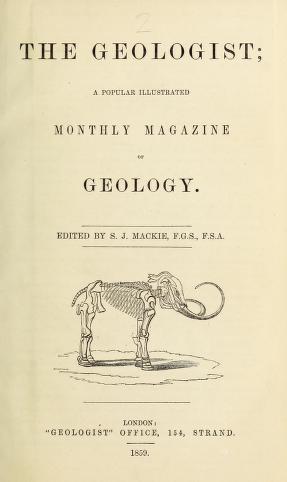S. J. Mackie and the Geologist
The life of a periodical editor in the nineteenth century was not an occupation for the easily discouraged. Financial precarity and the worry of finding sufficient material for each issue were constant struggles for many, particularly as the print market became increasingly crowded. Periodicals were often short-lived, lucky to exist for more than a few years before collapsing under the strain. The career of Samuel Joseph Mackie (1823-1902), editor of the Geologist (1858-1864), is a particularly remarkable example of such a career.
There is a great deal we do not know about the life of S. J. Mackie. No known image of him exists, and we must surmise much from the scattered traces of his chequered path through the world of scientific publishing. Born in Folkestone, Mackie's interest in geology began from an early age. By his late twenties, he was employed as a customs officer, but had also been elected as a Fellow of the Geological Society on the strength of his scientific work. However, a financial scandal involving his father cast a shadow over his early career, leaving Mackie bankrupt and forcing him to relocate to London. It is not clear how he earned a living at this stage, but Mackie next emerges as editor of a new periodical, the Geologist, in 1858. The preface asks for correspondents to 'join in aiding me in my earnest desire to popularize and to extend the noble science of geology without sacrificing, in any way, its proper dignity'. Mackie was prone to grandiloquence, clearly believing his role as editor was one weighted with great responsibility. 'Nothing once printed is innocuous or inert', he stated, pointing to the importance of periodicals to the advancement of science, as the 'magazine is bound into a volume, and may be read again months or years afterwards, and become, as it often does, the first course of instruction to younger minds'.

Title page of the Geologist's second volume
The Geologist was a self-described 'popular illustrated monthly magazine'. It shared the ideology common to many other natural history periodicals of this period - such as the Zoologist, for example - in inviting contributions from anyone who had something of interest to share. 'In every corner of the country where a labourer in the Geological field is to be found, there exists a man who has it in his power to uphold the Geologist, and by upholding it, to foster Science'. Geology was a particularly popular and fashionable subject, as Mackie himself observed: 'it is wondered at, and enquired about' by a large section of the public 'who cannot help noticing as they walk about the country, the earth is deposited in layers or strata; who see fossils dug out of railway cuttings, or who stop to gaze in astonishment, blended with incredulity, at the restorations of uncouth antediluvian creatures in the gardens of the Crystal Palace'. Despite this apparent appetite, the Geologist struggled financially for most of its existence. It came to an unexpected close in 1864, when its publishers sold the periodical for a measly £25. The new owners, Longman, Green, & Co., begun their own periodical, the Geological Magazine (1864-). Mackie admitted defeat, deciding to 'retire from the field rather than take part in a contest that might prove injurious to both'.
Mackie's enthusiasm for periodicals was clearly not overly dampened by the ignoble end of the Geologist, and in 1865 he commenced another publication along similar lines. This journal was comprehensively entitled the Geological and Natural History Reportory. Just in case the scope of the periodical was in doubt, Mackie appended an extended subtitle, describing it as an 'Illustrated Popular Weekly Magazine of Geology, Palaeontology, Mineralogy, Natural History, Terrestrial and Cosmical Physics, and Journal of Pre-Historic Archaeology and Ethnology'. The expanded remit of this new publication is most likely an attempt to maximise subscribers by appealing to as broad an audience as possible. Mackie noted that 'no special-class scientific periodical has ever yet attained a higher circulation than from 800 to 1000', yet 'it is certain that the quantity of matter now given could not be continued unless a very much more extensive patronage be accorded to the present effort'. Mackie was publishing at his own expense, and therefore some caution was necessary. Despite the promise of 'weekly' issues, it began at a monthly rate 'until sufficient promise of support has been received to ensure him [Mackie] against serious pecuniary loss'. However, it would appear that the required number of readers was not forthcoming, and the Reportory was therefore hampered from the beginning. The erratic publication schedule continued, barely reaching a single volume's length in over two years. The final issue ends mid-sentence in 1869.
After the failure of the Reportory, Mackie gave up on editorship and took up employment as a civil engineer. Furthermore, he turned his hand to inventing, filing patents for various contraptions of dubious ingenuity, including a design for a cross-channel ferry intended to alleviate sea sickness. None of these patents ever went beyond the drawing board, and Mackie lived out the rest of his years in relative obscurity.
--Matthew Wale



